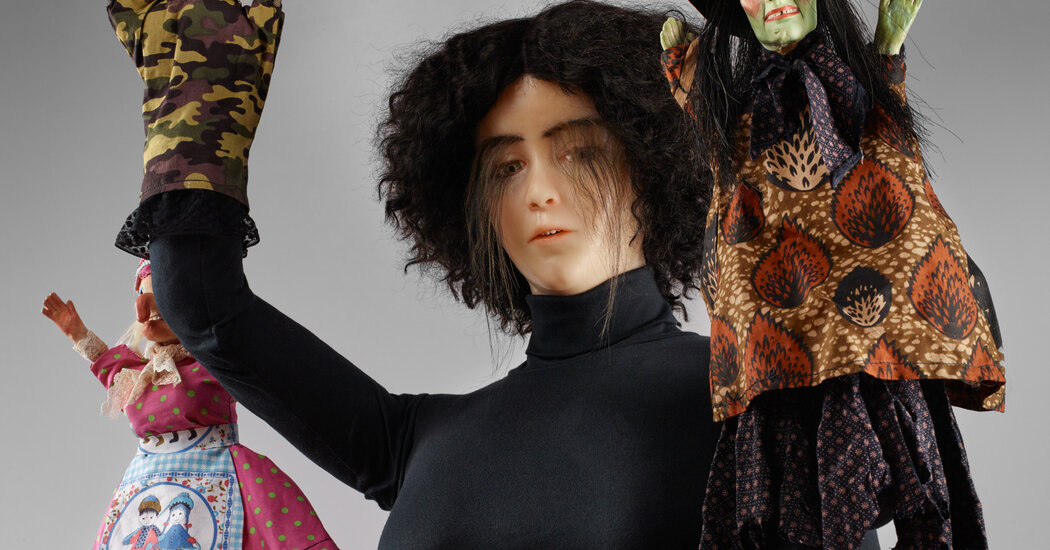Like many people, I have a love-hate relationship with social media: sometimes I’m thrilled by the genuine sense of connection it provides, other times I feel pressured to perform for a distant audience. It’s that second feeling I thought about while visiting Shary Boyle’s “Outside the Palace of Me” at the Museum of Arts and Design (MAD), an exhibition that considers how we create our identities and present them to others — and in turn, how those performances feed back into who we are.
To visit the show is to step into Boyle’s palace, or at least one wing of it. After passing through a curtained entryway, you’re greeted by a dazzling textile baluster mounted on a coin-operated pottery wheel, a life-size wax puppeteer with a twitching hand; an array of mythological porcelain and terra-cotta figurines and a towering sculpture of a woman with an animatronic spinning head. “Outside the Palace of Me” is a contemporary art fun house — only the fun isn’t as innocent and uncomplicated as it was in childhood.
The exhibition originated at the Gardiner Museum in Toronto, where Boyle was raised and still lives. Growing up, she played in punk bands and went to art school, eventually combining her interests in live performances where she created animations on an overhead projector while sharing the stage with musicians like Feist.
In the 2000s, Boyle began to make ceramics inspired by the porcelain figurines that were popular among the elites of 18th-century Europe. But she gave her sculptures surreal, feminist twists, as in “Ouroboros” (2006), which depicts a woman lying on her back with a chain of identical heads sprouting from her face; they arc their way back to the space between her flung-open legs — a wryly suggestive image.
Boyle, who represented Canada at the 2013 Venice Biennale, is something of a polymath: She’s continued to make ceramics, performances and animations, while also delving into film, painting and textiles — and all these media are represented at MAD. But collaboration is a central part of her practice; she doesn’t seek to master everything alone. For “Outside the Palace of Me,” she worked with the head of wardrobe at the National Ballet of Canada and a longtime attraction designer at Niagara Falls, among others. Her inspirations, many of which she details in the catalog, are wide-ranging, from illuminated medieval manuscripts to Mary Anne Talbot, an 18th-century Englishwoman who enlisted as a man.
The artworks in the show revel in dramatic effects, from actual moving parts to static pieces like “Peacock Spider” (2020), a ceramic rendering of the arachnid perched atop an outstretched hand with long, loud nails. Boyle is fascinated by how we create and act out ourselves. Consider, for example, “Judy” (2021), a wax figure of a woman dressed in black stagehand attire whose four arms hold four puppets: a wife, an activist, a witch, and a crone. (Boyle calls this last one “the worrier.”) Are these aspects of Judy’s personality that she draws on and orchestrates as needed, or are they imposed archetypes that control Judy, forcing her into a kind of song and dance? What’s more, Judy looks young, but her eyelashes are impossibly long, forming streams that evoke tears. How long has she been doing this act?
On the wall behind “Judy” is a painted ring of bright, concentric circles reminiscent of a “Looney Tunes” logo. Directly across the gallery, another sculpture sits against a similar background (although in black and white, it recalls “The Twilight Zone”): “White Elephant” (2021), an oversize rendering of a white woman dressed in white. She looks ghostly but mundane in her knit sweater; if only her head, with its startled face, didn’t periodically spin 360 degrees and her proportions weren’t so awkward.
“White Elephant” is an impressively adept commentary on race, a visualization of what often remain invisible: how whiteness can distort and confuse its privileged subjects. But it’s a subtle message and many viewers might miss it, waiting with their cameras poised to catch the whirling head. And therein lies the uneasy tension within the “Palace”: The optical effects are delightful, but they’re also social media fodder; it’s unclear how much they help engage the viewer in genuine reflection versus distracting us from doing so.
The “Palace” occupies MAD’s fifth floor, while on the fourth, a tandem presentation called “Foreshadows” displays related, previous work by Boyle. The mood downstairs is different — less theme park, more theater. The star of this show is “The Trampled Devil” (2022), a video that Boyle made for the Kaunas Biennial in Lithuania. Fittingly for her love of obscurities, it was inspired by an object in the Žmuidzinavičius Museum, which is devoted to sculptural depictions of the devil. Boyle’s almost 15-minute video, set to haunting music, features her as a series of characters — including an archangel, a financier (who looks like Andy Warhol), and a bat — battling for the soul of the earth.
Watching it multiple times, I found myself in awe, aware of the simultaneous vastness and smallness of my own humanity. This was a feeling I hadn’t been able to access in the clamor upstairs. Its appearance seemed to point to the consummate lesson of social media: Life may be largely a performance, but the nature of it changes depending on who you’re acting for.
Shary Boyle: Outside the Palace of Me
Through Feb. 25, 2024, at the Museum of Arts and Design, 2 Columbus Circle, Manhattan; (212) 299-7777, madmuseum.org.

